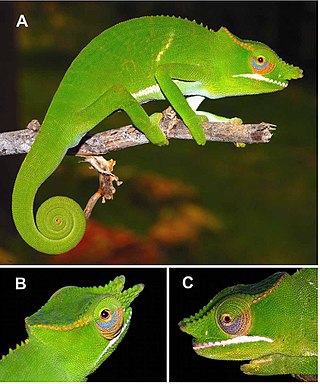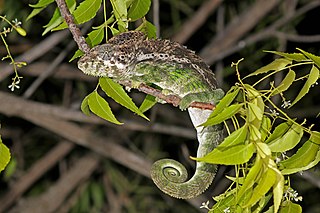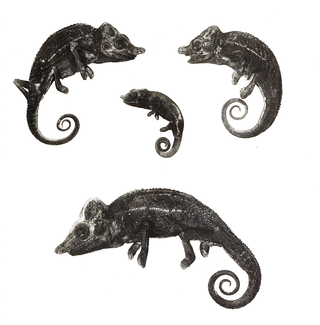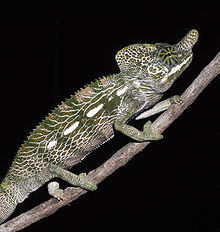
Chameleons or chamaeleons are a distinctive and highly specialized clade of Old World lizards with 200 species described as of June 2015. The members of this family are best known for their distinct range of colors, being capable of shifting to different hues and degrees of brightness. The large number of species in the family exhibit considerable variability in their capacity to change color. For some, it is more of a shift of brightness ; for others, a plethora of color-combinations can be seen.

The veiled chameleon is a species of chameleon native to the Arabian Peninsula in Yemen and Saudi Arabia. Other common names include cone-head chameleon, Yemen chameleon, and Yemeni chameleon. They are born pastel green and without their distinctive casques on their head. They grow this as well as become more colorful as they mature. They are known for their variable color changes due to a variety of factors, including to show aggression, social status, reproduction, and stress. Females live around five years and males live for around eight and they breed a few times a year.

The panther chameleon is a species of chameleon found in the eastern and northern parts of Madagascar in a tropical forest biome. Additionally, it has been introduced to Réunion and Mauritius, as well as the state of Florida within the United States.

The yellow-legged buttonquail is a buttonquail, one of a small family of birds which resemble, but are unrelated to, the true quails. This family is peculiar in that the females are larger and more colourful than the males and are polyandrous.

Parson's chameleon is a species of chameleon in the family Chamaeleonidae that is endemic to eastern and northern Madagascar. It is found from lowlands to an altitude of 1,195 m (3,920 ft) above sea level and mainly inhabits humid primary forest, but can also occur in disturbed habitats with trees. For a chameleon, it is very large, long-lived and slow-reproducing.

The Malagasy giant chameleon or Oustalet's chameleon is a large species of chameleon which is native to entire Madagascar, but also has been introduced near Nairobi in Kenya and in Miami-Dade County in the United States. It occurs in a wide range of habitats, even among degraded vegetation within villages, but is relatively rare in the interior of primary forest.

The jeweled chameleon, also commonly known as Campan's chameleon or the Madagascar forest chameleon, is a species of lizard in the family Chamaeleonidae. The species is endemic to the central highlands of Madagascar, where it is threatened by bush fires and habitat loss.

The lesser chameleon or minor chameleon is a species of lizards in the family Chamaeleonidae. It is endemic to Madagascar.

The common agama, red-headed rock agama or rainbow agama is a species of lizard from the family Agamidae found in most of sub-Saharan Africa. To clear up historical confusion based on Linnaeus and other authors, Wagner, et al. (2009) designated a neotype for the species, using a previously described specimen from Cameroon in the collection of the Zoologisches Forschungsmuseum Alexander Koenig in Bonn. The species name was formerly applied to a paraphyletic collection of taxa, and mitochondrial DNA analysis of various populations indicates they represent separate species., Consequently, three former subspecies A. a. africana, A. a. boensis, and A. a. mucosoensis are now considered separate species, and A. a. savattieri is considered synonymous with A. africana.
Semelparity and iteroparity are two contrasting reproductive strategies available to living organisms. A species is considered semelparous if it is characterized by a single reproductive episode before death, and iteroparous if it is characterized by multiple reproductive cycles over the course of its lifetime. Iteroparity can be further divided into continuous iteroparity and seasonal iteroparity Some botanists use the parallel terms monocarpy and polycarpy.

The rhinoceros chameleon is a species of chameleon that gets its common name from its horn-like nose which is most prominent in males. It is endemic to dry forests in Madagascar.

The Angel's chameleon, initially described as Chamaeleo angeli, is a species of chameleon, a lizard in the family Chamaeleonidae. The species is endemic to Madagascar, and was originally described by Édouard-Raoul Brygoo and Charles Antoine Domergue in 1968.

Furcifer balteatus, also known as the two-banded chameleon or the rainforest chameleon, is a species of chameleon that is endemic to Madagascar. It was described by André Marie Constant Duméril and Gabriel Bibron in 1851.

The carpet chameleon, also known as the jewel chameleon or white-lined chameleon, is a species of chameleon that is endemic to eastern Madagascar. It is a relatively small chameleon and especially females tend to have bright markings in many colours, whereas males are mostly green and whitish or green and yellowish.

The Antimena chameleon is a species of chameleon that is endemic to southwest Madagascar. It was initially described by French naturalist Alfred Grandidier in 1872.

The Petter's chameleon is a species of chameleon, which is endemic to northern Madagascar. Furcifer petteri was initially described as the subspecies Chamaeleo willsii petteri by Édouard-Raoul Brygoo and Charles Domergue in 1966, but later transferred to the genus Furcifer and given full species status by Frank Glaw and Miguel Vences in 1994.

Furcifer timoni is a species of chameleon, a lizard in the family Chamaeleonidae. The species is endemic to Madagascar.

Furcifer verrucosus, also known as the warty chameleon, spiny chameleon or crocodile chameleon, is a species of reptile endemic to Madagascar. It was first described by Georges Cuvier in 1829.

Voeltzkow's chameleon is a species of chameleon that is endemic to Madagascar. The species was described by Oskar Boettger in 1893, from an adult male specimen collected by A. Voeltzkow.

Furcifer viridis, the green chameleon, is a species of chameleon found widely in forest, scrub and grasslands in western and northern Madagascar. Females are up to 19 cm (7.5 in) in total length and typically mottled or banded in pinkish and green, whereas males are up to 28 cm (11 in) in total length are mostly greenish, typically with pale edging to their mouth and a pale horizontal stripe along the middle of their body. It was formerly considered a part of F. lateralis, but was recognized as a separate species in 2012.






















